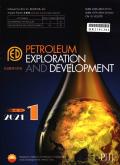Characteristics of hydraulic fracture network in the tight conglomerate reservoir based on a hydraulic fracturing test site
IF 8
Q1 ENERGY & FUELS
引用次数: 0
Abstract
In order to identify the development characteristics of fracture network in tight conglomerate reservoir of Mahu after hydraulic fracturing, a hydraulic fracturing test site was set up in the second and third members of Triassic Baikouquan Formation (T1b2 and T1b3) in Ma-131 well area, which learned from the successful experience of hydraulic fracturing test sites in North America (HFTS-1). Twelve horizontal wells and a high-angle coring well MaJ02 were drilled. The orientation, connection, propagation law and major controlling factors of hydraulic fractures were analyzed by comparing results of CT scans, imaging logs, direct observation of cores from Well MaJ02, and combined with tracer monitoring data. Results indicate that: (1) Two types of fractures have developed by hydraulic fracturing, i.e. tensile fractures and shear fractures. Tensile fractures are approximately parallel to the direction of the maximum horizontal principal stress, and propagate less than 50 m from perforation clusters. Shear fractures are distributed among tensile fractures and mainly in the strike-slip mode due to the induced stress field among tensile fractures, and some of them are in conjugated pairs. Overall, tensile fractures alternate with shear fractures, with shear fractures dominated and activated after tensile ones. (2) Tracer monitoring results indicate that communication between wells was prevalent in the early stage of production, and the static pressure in the fracture gradually decreased and the connectivity between wells reduced as production progressed. (3) Density of hydraulic fractures is mainly affected by the lithology and fracturing parameters, which is smaller in the mudstone than the conglomerate. Larger fracturing scale and smaller cluster spacing lead to a higher fracture density, which are important directions to improve the well productivity.
基于水力压裂试验场的致密砾岩储层水力裂缝网络特征
为识别麻湖致密砾岩储层水力压裂后裂缝网络发育特征,借鉴北美水力压裂试验场(HFTS-1)的成功经验,在马131井区三叠系百口泉组二段和三段(T1b2和T1b3)建立了水力压裂试验场。共钻了12口水平井和1口MaJ02大角度取心井。通过对比MaJ02井CT扫描、成像测井、岩心直接观测结果,并结合示踪剂监测数据,分析水力裂缝的走向、连接、扩展规律及主要控制因素。结果表明:(1)水力压裂发育了两种类型的裂缝,即张缝和剪切缝。张性裂缝大致平行于最大水平主应力方向,并且从射孔簇扩展不到50 m。剪切裂缝分布在张性裂缝中,受张性裂缝间诱发应力场的影响,以走滑模式为主,部分为共轭对。总体上,拉伸裂缝与剪切裂缝交替出现,剪切裂缝占主导地位,并在拉伸裂缝之后激活。(2)示踪剂监测结果表明,在生产初期,井间通通性普遍存在,随着生产的进行,裂缝内静压逐渐降低,井间连通性降低。(3)水力裂缝密度主要受岩性和压裂参数的影响,泥岩中的水力裂缝密度小于砾岩。更大的压裂规模和更小的簇间距导致更高的裂缝密度,这是提高油井产能的重要方向。
本文章由计算机程序翻译,如有差异,请以英文原文为准。
求助全文
约1分钟内获得全文
求助全文

 求助内容:
求助内容: 应助结果提醒方式:
应助结果提醒方式:


